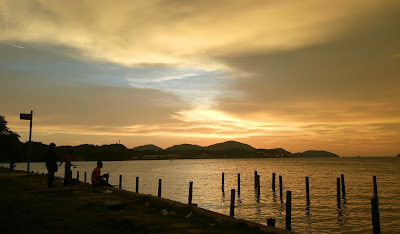Trong is not very far from Taiping and it was at the latter that we stayed for the night. Taiping is an interesting town with quite a bit of history. It used to be the capital of Perak before Ipoh took over the role in 1937. It has a number of tourist attractions within its vicinity, the most famous of which is perhaps the picturesque Lake Gardens. But I'm not going to write about the gardens, or the zoo, or Bukit Larut (Maxwell Hill) or even the savoury delights of mee udang Kuala Sepetang. Instead, I'll write about two lesser-known places.
1. Taiping War Cemetery
On the road leading to the foothill of Bukit Larut, you will pass by a serene and well-kept graveyard that is the final resting place of Allied servicemen killed during World War II. When the war ended, the British military authorities headed by Major JH Ingram, decided to move the remains of their fallen personnel, spread over various villages and temporary burial grounds, to a common cemetery where the men would be honoured and remembered.
There are more than 850 graves at the cemetery, including more than 500 who remain unidentified. The cemetery is divided into two parts on either side of the road to Bukit Larut. One side holds the Christian graves while the other hold the Muslim and other denominations. If you observe carefully, the headstones on the Muslim graves are at an angle to the central dividing road whereas the Christian headstones are perpendicular. This is because the Muslims are buried facing the qibla in accordance to religious requirement.
The upkeep and maintenance of this war memorial is under the responsibility of the Commonwealth War Graves Commission, which explains why the place looks very tidy. A slight drawback is the absence of a proper parking space. To stop and visit, I had to park my car by the roadside where the narrow side-table meant that half of the car's width still sat on the roadway. Luckily, the road to Bukit Larut is not that busy, otherwise the obstruction would surely inconvenience other road users.
 |
| A low wall marks the perimeter of Taiping War Cemetery. Visited 30 April 2017 |
 |
| The Muslim section of the graveyard |
2. Kota Ngah Ibrahim
Ngah Ibrahim was a Malay statesman from Perak and administrator of the Larut district in the 1870s. The `kota' was his private residence. Although not quite a fort in the strictest translation of the word, the two-storey house sits within a large compound that is enclosed by a high brick wall. For its size at that period of time, it is quite obvious that the owner was a very rich man.
Kota Ngah Ibrahim is now officially known as the Matang Museum. It is located about 8km from Taiping on the Kuala Sepetang road. The building has an illustrious history. Apart from being the home of a local headman, the British used it as a court to hear the case of the murder of JWW Birch, the first Resident of Perak. On 2 November 1875, Birch was killed by a group of Malay men led by Dato Maharajalela while taking a bath by a river in Pasir Salak.
The trial was held from 14 to 22 December 1876. At the end of the proceedings, three men including Dato Maharajalela were sentenced to death by hanging. The other two were Dato Sagor and Pandak Endut. The hanging was carried out in Taiping on 20 January 1877. Dato Maharajalela's real name was Lela Pandak Limo, son of a Bugis king from Sulawesi. The 'maharajalela' title was awarded by the sultan to one his ministers with the specific authority to decapitate anyone who oppose the king. Nowadays, the Malay word maharajalela carries the meaning of someone who acts or does things as he pleases or out of control. The word is almost always used in the negative sense.
Sultan Abdullah and Ngah Ibrahim were also found guilty of collaborating in the assassination of the British Resident. Both were exiled to the islands of Seychelles in the Indian Ocean. Ngah Ibrahim was later allowed to return to Singapore where he died in 1887. He was initially buried within the Aljunied Mosque compounds in Singapore but in September 2006, his remains was brought back to Perak and re-buried near his house.
The artifacts on display at the present-day museum are really nothing fancy or impressive. The main exhibit on the upper floor of the house is a mock-up of the courtroom where the trial of the Birch killers was held. Although the displays were static and simple, I thought that it was 45 minutes of my time well-spent. I learned a bit more of Perak's history in that short visit compared to the actual classes in school. Admission is free.
In the neighbouring compound beyond the walls of Ngah Ibrahim's fort is another old building which used to be the dwelling of the first Assistant Resident of Perak, Captain Speedy. The house seems well-preserved but was not open to the public.
 |
| Home of a Perak statesman |
 |
| Part of exhibits on the ground floor |
 |
| Present-day grave of Ngah Ibrahim that was relocated from Singapore |
 |
| Historical personalities of Perak during those turbulent times |
 |
| Courtroom mock-up of the Birch murder trial |
 |
| House of the Assistant Resident of Perak |
 |
| The Matang Museum as viewed from one corner of the boundary walls |















































